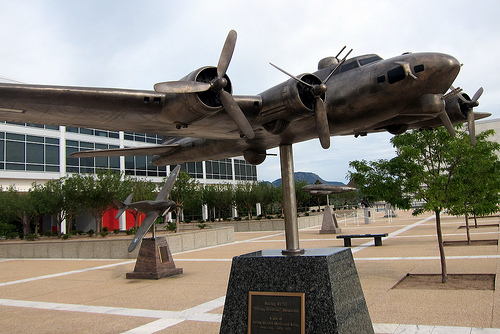Jabara, James "Jabby"
- Date of birth:
- October 10th, 1923 (Muskogee/Oklahoma, United States)
- Date of death:
- November 17th, 1966 (Delray Beach/Florida, United States)
- Buried on:
- Arlington National Cemetery
Plot: 2. Grave: E-478-D. - Service number:
- 16309A
- Nationality:
- American
Biography
Do you have more information about this person? Inform us!
- Period:
- Korean War (1950-1953)
- Rank:
- Captain
- Unit:
- 334th Fighter-Interceptor Squadron, 4th Fighter-Interceptor Wing, U.S. Air Force
- Awarded on:
- May 22nd, 1951
General Headquarters Far East Command: General Orders No. 131
- Period:
- Korean War (1950-1953)
- Rank:
- Captain
- Unit:
- 334th Fighter-Interceptor Squadron, 4th Fighter-Interceptor Wing, U.S. Air Force
- Awarded on:
- June 7th, 1951
"For gallantry in action against an armed enemy of the United Nations while serving with the 334th Fighter-Interceptor Squadron, 4th Fighter-Interceptor Wing, FIFTH Air Force, in action against enemy forces in the Republic of Korea, on two consecutive missions, 10 and 12 April 1951. On 10 April 1951, Captain Jabara led his squadron through adverse weather conditions to the target area at Sinuiju, Korea, without visual reference to the ground. To effectively accomplish his mission, Captain Jabara descended through the overcast from 38,000 feet to 12,000 feet whereupon he deployed his squadron for maximum combat effectiveness. When a large formation of enemy jet aircraft was sighted he immediately pressed the attack. His attacks were so vicious that one of the enemy pilots was forced to abandon his plane and parachute to safety. Although his aircraft was low on fuel and no ammunition remained, Captain Jabara returned to the target area where he reassembled his squadron and led them to the home base. On 12 April 1951, Captain Jabara was leading his flight of F-86 aircraft on a B-29 escort mission in the Sinuiju-Yalu river area. When enemy aircraft attacked the bombing formation, Captain Jabara displayed exemplary tactical utilization of his forces. By vicious counter-attacks, Captain Jabara's flight repelled the enemy, forcing then to withdraw across the Yalu river. During these relentless attacks, Captain Jabara destroyed one of the enemy aircraft attacking the bombers. Captain Jabara's gallantry, determination to accomplish his assigned mission, and complete disregard for his own personal safety was in the highest traditions of the service, and brought great credit upon himself, the Far East Air Forces, and the United States Air Force."
Headquarters, Far East Air Forces, General Orders No. 262
Headquarters, Far East Air Forces, General Orders No. 262
- Period:
- Korean War (1950-1953)
- Rank:
- Captain
- Unit:
- 334th Fighter-Interceptor Squadron, 4th Fighter-Interceptor Wing, U.S. Air Force
- Awarded on:
- June 7th, 1951
Headquarters, Far East Air Forces, General Orders No. 262 (bronze oak leaf cluster)
- Period:
- Vietnam War (1955-1975)
- Rank:
- Colonel
- Unit:
- 31st Tactical Fighter Wing, U.S. Air Force
Posthumously awarded
- Period:
- Second World War (1939-1945)
- Rank:
- 1st Lieutenant
- Unit:
- 363rd Fighter Group, U.S. Army Air Forces
- Period:
- Second World War (1939-1945)
- Rank:
- 1st Lieutenant
- Unit:
- 363rd Fighter Group, U.S. Army Air Forces
Bronze oak leaf cluster
- Period:
- Second World War (1939-1945)
- Rank:
- 1st Lieutenant
- Unit:
- 363rd Fighter Group, U.S. Army Air Forces
2nd bronze oak leaf cluster
- Period:
- Korean War (1950-1953)
- Rank:
- Captain
- Unit:
- 334th Fighter-Interceptor Squadron, 4th Fighter-Interceptor Wing, U.S. Air Force
3rd bronze oak leaf cluster
- Period:
- Korean War (1950-1953)
- Rank:
- Captain
- Unit:
- 334th Fighter-Interceptor Squadron, 4th Fighter-Interceptor Wing, U.S. Air Force
4th bronze oak leaf cluster
- Period:
- Korean War (1950-1953)
- Rank:
- Captain
- Unit:
- 334th Fighter-Interceptor Squadron, 4th Fighter-Interceptor Wing, U.S. Air Force
Silver Oak Leaf Cluster (6th award)
- Period:
- Korean War (1950-1953)
- Rank:
- Captain
- Unit:
- 334th Fighter-Interceptor Squadron, 4th Fighter-Interceptor Wing, U.S. Air Force
Bronze Oak Leaf Cluster in addition to a previously awarded Silver Oak Leaf Cluster (7th award)







